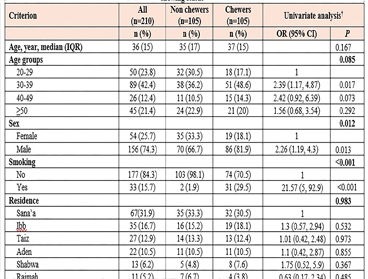Association between khat chewing and high viral load in chronic hepatitis B infection
Main Article Content
Abstract
Background and aims: chronic hepatitis B infection (CHB) is a worldwide health threat that has moderate to high prevalence in Yemen. There is accumulating evidence of the hepatotoxicity of khat, which is commonly and habitually chewed in Yemen and elsewhere, but little is known in CHB. This study aimed to examine the association between khat chewing and hepatitis B virus (HBV) serum DNA level (viral load) in such cases. Methods: Between January and December 2016, a cross-sectional study was carried out on consecutively consenting 210 CHB participants (khat chewers and non-chewers) attending the hepatology clinics of two major hospitals in Sana’a city. After a structured interview, blood samples were collected for the determination of HBV markers and HBV load. Results: the study population, residing different cities in Yemen, had a median age of 36y (range = 20-72) with a 2.9:1 male to female ratio. Viral load was significantly (P<0.001) higher among khat chewers than non-chewers: median (Interquartile range) = 1308 (531.5-5916.5) vs 177 (60-627) IU/ml. Khat chewing was observed, via multivariate logistic regression analysis, to be significantly (pThe0.001) and independently associated with a clinically significant high HBV load (>2000 IU/ml) even after adjustment for the studied socio-demographic and laboratory factors. Conclusion: This study suggests khat chewing, especially on a daily basis, as a potential risk factor for high viremia and, therefore, be prudently discouraged in CHB.
Downloads
Article Details

This work is licensed under a Creative Commons Attribution-NonCommercial-NoDerivatives 4.0 International License.

